Romanian volunteers. Combat path divisions "Tudor Vladimirescu" and "Horia, Shi shi Krishan"
The dream of "Great Romania"
The goal of the Romanian nationalists, who established themselves in power in the country, was the revival of "Greater Romania". Although such a state never existed in nature, nationalists argued that Romania historically belonged not only to the land of Moldova, but also to the land of the Odessa, Vinnitsa and Nikolaev regions of Ukraine - the so-called “Transnistria”. According to this concept, the population of these territories is Russified Romanians, and not Russians and Ukrainians. Accordingly, Romania, entering the Second World War on the side of Germany, hoped to annex these lands to its territory. Moreover, Germany did not allow Romania to put forward territorial claims for Transylvania, which was part of Hungary, and Dobrudzha, promised by Bulgaria.
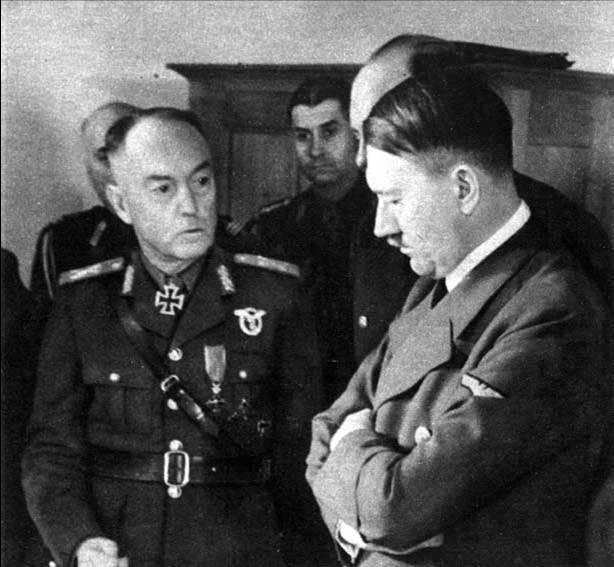
- Adolf Hitler and Marshal Antonescu
The nationalists planned to lead the Eastern border of Great Romania along the Southern Bug, although ideas were expressed to bring it to the Dnieper. The ultraradical Romanian politicians called for the border to be set across the Urals to create the widest possible space for the reproduction of the Romanian people. Of course, plans to expand the Romanian territory to the Urals could not cause anything but a smile, but Germany did not object to the seizure by Romania of the territory of a part of Ukraine and Moldova. Romania went to an alliance with Germany, including because it sought to prevent the growth of pro-communist sentiments on its territory. Although in Romania, unlike, say, Greece or Yugoslavia, communist sentiment did not enjoy such influence. The Romanian peasantry, which constituted the bulk of the country's population, was for the most part conservative, under the strong influence of the Orthodox Church and adhered to anti-Semitic sentiments. There were many Romanian Jews among the Communists, so the peasants were not inclined to support the Communist Party. Caused by the concerns of the Romanian peasantry and the policy of collectivization in the Soviet Union, as well as atheistic propaganda. Secondly, attempts to create a strong Communist Party in Romania were brutally suppressed by the country's authorities back in the 1920s - 1930s. Activists of the Romanian Communist Party were subjected to repression, they were killed and imprisoned. Very brutally, the Romanian authorities suppressed the famous Tatarbunarian uprising of 1924 in Bessarabia (Tatarbunary is now located in the Odessa region of Ukraine). The Bolshevik Party led the Bessarabian peasant revolt, and at least six thousand people took part in it. It was sunk in the blood by Romanian troops. However, in the territory of Romania itself, the communist party in the interwar period was never able to gain serious influence, remaining a small group whose activities were completely directed by the Comintern and the leadership of the Soviet Union.
Romania’s participation in the occupation of Soviet territory
June 22, 1941 at 3.15. Romanian troops invaded the territory of the USSR. The 3rd and 4th Romanian armies, the Romanian took part in the attack on the Soviet Union aviation. The Moldavian SSR, the Chernivtsi and Akkerman regions of the Ukrainian SSR, the Crimean ASSR, the RSFSR were attacked by Romanian aviation. The artillery of the ground forces began shelling Soviet settlements on the north bank of the Danube and the left bank of the Prut, after which the infantry and cavalry units began to force the Prut, Dniester and Danube. Thus began the war of Romania with the Soviet Union. When Hitler’s troops, the Romanians played a supporting role, because the Romanian army could not compete with the Red Army in terms of strength, number of weapons and the level of training of personnel. Nevertheless, it was the Romanian divisions that were destined to play a key role in the offensive on Soviet territory in Bessarabia and Bukovina, Odessa region. The 4th Romanian army with a total number of 340 thousand people participated in the attack on Odessa. However, the low level of training and personal qualities of a significant part of the Romanian army personnel ensured the high losses of the Romanian units during the assault on Odessa, amounting to 90 soldiers and officers. Thus, the attack on Odessa was difficult for the Romanian side, and Bucharest demanded immediate assistance from German units from Berlin. It is not known how many more soldiers and officers of the Romanian army would have died in the battles for Odessa if the Soviet command had not made a strategic decision on the meaninglessness of further protection of Odessa and completed the retreat of the Red Army units from the territory of the city and its environs by October 000, 16. Romanian troops entered Odessa. The city was proclaimed the capital of the emerging Romanian Transnistria.
- Romanian officers on Soviet soil
Three Romanian governorates were established in the occupied Soviet land - Bukovinsky with its capital in Chernivtsi, Bessarabia with its capital in Chisinau and Transnistria with its capital in Tiraspol, and then in Odessa. Romanian governors were appointed to all the governorates, the Romanian authorities and the police were formed, and a policy of the Romanian local Moldovan, Ukrainian, and Russian population began. It consisted primarily in limiting the use of Russian and Ukrainian languages, replacing Slavic names with Romanian ones, introducing the Romanian language in schools and official documentation, and promoting “Romanianism” among the local population. At the same time, Romania launched a tough anti-Semitic policy in the occupied territories. Ethnically, the population of the captured regions of the USSR was divided into three groups. The first included the Romanians, the second - the national minorities, the third - the Jews. The latter were driven into a ghetto, and then began to be transported to concentration camps created by the Romanian authorities. The destruction of Soviet civilians in the occupied territory began from the first days of the occupation. In Odessa, 17-3 had already shot thousands of Jewish men in October 4, October 23 thousands of civilians (in retaliation for the October 5 bombing of the Romanian commandant’s office, which killed the Romanian army 22, including the 66 general). In artillery depots outside Odessa, Red Army prisoners of war, communists, Komsomol and Soviet activists were killed. October 1 at Dalnik Post were burned alive in the 24 barracks of thousands of Jews. Only from 5 December 21 to 1941 February 15 1942 44 Jews of Odessa and the Odessa region were shot. Thousands of Jews were deported from Bessarabia and Bukovina to Transnistria, almost all of them were killed. It is significant that part of the local population welcomed the Romanian occupation administration. First of all, they were Moldovans, as well as representatives of the peasantry, people offended by the Soviet authorities. For the most part, they constituted the authorities and police of the Romanian governorates, but many officials, especially of a high level, were sent from Romania.
By the occupation of Bessarabia, Bucovina and Transnistria, Romania’s participation in the aggressive war against the Soviet Union was not over. The Romanian troops continued their offensive to the east, acting as the “junior allies” of the Hitler army. By the way, the generals of the Wehrmacht had a rather low opinion of the fighting qualities of the majority of Romanian soldiers and officers. In addition, the Romanian soldiers discredited themselves by looting in the occupied territories, for which they were punished by the German command. A large proportion of Romanian servicemen fell into Soviet captivity and was sent to prison camps. Many Romanian soldiers and officers initially did not support the war, and their participation in hostilities was caused only by the pursuit of military discipline and the fear of punishment from the command. Therefore, once captured, they began to convince the Soviet leadership in their anti-fascist sentiments. Moreover, after the Battle of Stalingrad and the subsequent retreat of the Hitlerites, the perception of the war itself, the perspectives of Germany in it and, accordingly, the allied relations of Romania with Germany, changed. 2 February 1943, a group of captured Romanian servicemen appealed to the Soviet government for volunteers to take them to the front to fight against fascism. The requests of the Romanian prisoners of war coincided with the plans of the Soviet leadership, therefore the USSR State Defense Committee decided to form a volunteer division in the Soviet Union staffed by Romanian military personnel.
First volunteer
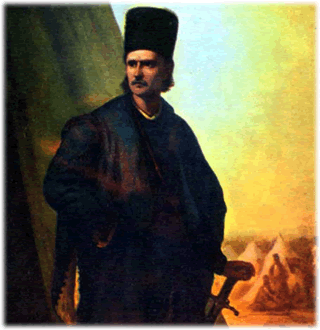 The division received the official name of the 1 of the Romanian Volunteer Infantry Division named after Tudor Vladimirescu (in the photo). Why Tudor Vladimirescu? This man was a national hero of Romania, whose name could unite adherents of various political views and representatives of various social groups in the country. There was another nuance in choosing the name - Tudor Vladimirescu in the period of the Russian-Turkish war 1806-1812. He fought at the head of the Valashish (Romanian) Volunteer Corps on the side of the Russian troops. In 1821, he led a popular uprising in Wallachia against the Turkish yoke and large local landowners, during which he was killed. Thus, the name “Tudor Vladimirescu” for the Romanian volunteer division as part of the Soviet army was most suitable - after all, Tudor fought on the Russian side at the head of the Romanian volunteers, sought to free Wallachia from foreign oppression and was a supporter of social justice.
The division received the official name of the 1 of the Romanian Volunteer Infantry Division named after Tudor Vladimirescu (in the photo). Why Tudor Vladimirescu? This man was a national hero of Romania, whose name could unite adherents of various political views and representatives of various social groups in the country. There was another nuance in choosing the name - Tudor Vladimirescu in the period of the Russian-Turkish war 1806-1812. He fought at the head of the Valashish (Romanian) Volunteer Corps on the side of the Russian troops. In 1821, he led a popular uprising in Wallachia against the Turkish yoke and large local landowners, during which he was killed. Thus, the name “Tudor Vladimirescu” for the Romanian volunteer division as part of the Soviet army was most suitable - after all, Tudor fought on the Russian side at the head of the Romanian volunteers, sought to free Wallachia from foreign oppression and was a supporter of social justice. The formation of the Tudor Vladimirescu division began in 1943 on the territory of the Ryazan region of the RSFSR - in the Selets camps for prisoners of war. The division was led by Colonel of the Romanian Army Nicolae Kambrya (1900-1976). Prior to getting into 1942, in the Soviet captivity, Kambrya was chief of staff of the Romanian 5 division. After the 4 of October 1943 of the USSR State Defense Committee adopted a resolution on the formation of the Tudor Vladimirescu division, on November 15 Kambre was appointed its commander and headed the division for a year. In fact, under his command, the division went from the initial stages of formation to participation in active hostilities. The chief of staff of the division became Colonel Iakob Teklu (in the photo), who later became its commander.
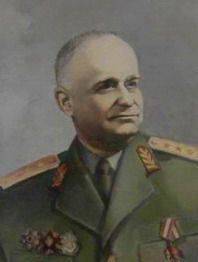 The personnel of the division consisted of 9 589 military personnel, including 895 officers, 4379 sergeants and 4315 privates. Mostly they were Romanian prisoners of war - soldiers, sergeants and officers, released from captivity and included in the division. Modern Western researchers argue that the backbone of the division was composed of those prisoners of war who had long ago collaborated with the Soviet command and in the camps for prisoners of war performed the functions of guards for German and Hungarian prisoners of war. But there were also divisions and Romanian communists sent by the Soviet leadership to organize political training of the personnel and strengthen communist agitation and propaganda. Also in the division were 159 personnel commanders of the Workers 'and Peasants' Red Army. Anna Pauker (1893-1960), a well-known activist of the Romanian communist movement, was appointed political commissar of the division. About this woman, whose name is inextricably linked story Romanian anti-fascist movement, should be told separately.
The personnel of the division consisted of 9 589 military personnel, including 895 officers, 4379 sergeants and 4315 privates. Mostly they were Romanian prisoners of war - soldiers, sergeants and officers, released from captivity and included in the division. Modern Western researchers argue that the backbone of the division was composed of those prisoners of war who had long ago collaborated with the Soviet command and in the camps for prisoners of war performed the functions of guards for German and Hungarian prisoners of war. But there were also divisions and Romanian communists sent by the Soviet leadership to organize political training of the personnel and strengthen communist agitation and propaganda. Also in the division were 159 personnel commanders of the Workers 'and Peasants' Red Army. Anna Pauker (1893-1960), a well-known activist of the Romanian communist movement, was appointed political commissar of the division. About this woman, whose name is inextricably linked story Romanian anti-fascist movement, should be told separately. 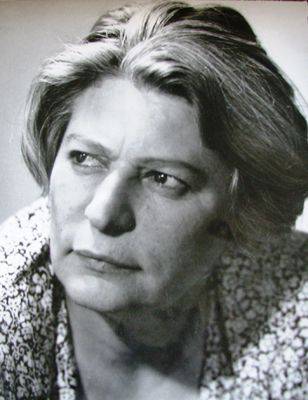 At birth, Anna Pauker was given the name and surname of Hanna Robinson, who came from a poor Jewish religious family. In her younger years, she worked as a teacher at a Jewish elementary school in Bucharest. In 1915, at the age of 22, she joined the Social Democratic Party of Romania and remained in it until the Communist Party of Romania was established in 1921 on the basis of the radical wing of the Democrats. In October, 1922, the second congress of the Communist Party, elected Anna a member of the Central Committee. One of the leaders of the Romanian Communists was her husband Marcel Pauker (1896-1938) - a prominent revolutionary with a tragic fate (he was repressed, having fled to the USSR from Romania, with life penal servitude). In 1935, Anna Pauker was arrested in Romania, but sent to the USSR in 1941. Here she lived in Moscow and managed in 1943-1944. overseas bureau of the Romanian Communist Party. Despite the fact that Pauker was Jewish and had a dubious reputation from the point of view of the Soviet leadership (her husband was repressed), she was the one who was most suitable for the position of political commissar of the formed Tudor Vladimirescu division.
At birth, Anna Pauker was given the name and surname of Hanna Robinson, who came from a poor Jewish religious family. In her younger years, she worked as a teacher at a Jewish elementary school in Bucharest. In 1915, at the age of 22, she joined the Social Democratic Party of Romania and remained in it until the Communist Party of Romania was established in 1921 on the basis of the radical wing of the Democrats. In October, 1922, the second congress of the Communist Party, elected Anna a member of the Central Committee. One of the leaders of the Romanian Communists was her husband Marcel Pauker (1896-1938) - a prominent revolutionary with a tragic fate (he was repressed, having fled to the USSR from Romania, with life penal servitude). In 1935, Anna Pauker was arrested in Romania, but sent to the USSR in 1941. Here she lived in Moscow and managed in 1943-1944. overseas bureau of the Romanian Communist Party. Despite the fact that Pauker was Jewish and had a dubious reputation from the point of view of the Soviet leadership (her husband was repressed), she was the one who was most suitable for the position of political commissar of the formed Tudor Vladimirescu division. In March 1944, the formation of the division and the retraining of its personnel were completed. All the soldiers of the division received the form of the old Romanian sample with the letters "TV", and the officers wore the Soviet uniform, but with Romanian shoulder straps, so that the Romanian soldiers could distinguish military ranks. The division’s servicemen were called pandurs. Pandury - the historical name of the border guards in the Austrian and Ottoman empires. In the Ottoman Empire, pandurs were formed in Wallachia from among the local peasants, who were given certain privileges for carrying out certain functions of protecting the border. However, the pandurs often rebelled because they were not satisfied with the conditions of their situation. During the Russian-Turkish war 1806-1812. on the side of the Russian Empire, the corps of Romanian volunteers fought — the pandurov, commanded by Tudor Vladimirescu. Thus, having called the soldiers and officers of the division pandurs, the historical continuity of the Russian-Romanian front-line fraternity, which was formed during the Russian-Turkish wars, was once again emphasized.
Pandurov's Battle Path “Tudor Vladimirescu”
In March, the 31 division of March was transferred to the command of the 2 Ukrainian Front in order by railroad echelons. The division, in addition to the headquarters, included three rifle regiments, an artillery regiment, a separate anti-tank fighter division, an anti-aircraft artillery battery, a separate communications battalion, an engineer battalion, a medical battalion, a reconnaissance and trucking company, a chemical defense company, a field bakery, a field battalion postal station, divisional veterinary infirmary, field ticket office of the State Bank. By the time the division was armed with 12 units. 122-mm howitzers, 20 pcs. divisional 76-mm guns, 12 pcs. regimental 76-mm guns, 48 pcs. anti-tank 45-mm guns, 21 pcs. 120-mm mortars, 83 pcs. battalion 82-mm mortars, 56 pcs. 50-mm mortars, 212 pcs. anti-tank guns, 111 pcs. machine guns, 494 pcs. light machine guns, 2116 pcs. submachine guns, 5244 pcs. rifles and carbines, 858 pcs. revolvers and pistols.
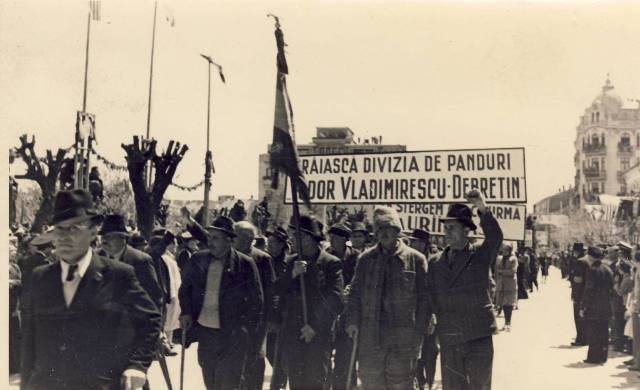
Also in the division there were 98 trucks, 6 cars and 17 special vehicles, 44 tractor, 4 motorcycle and 59 radio stations. Thus, the Romanian volunteer unit was well armed and was ready to move to the scene of hostilities. But until August she was in the rear - it took time for the political treatment of the personnel of the division, for distribution among the soldiers and officers of the communist ideology. Directly to the front, the division was sent only in August 1944. On August 29, the division entered the battle near the villages of Deleni and Sfântu, south of the city of Vasilui in Romania. During the clash with a group of German soldiers killed a few dozen Romanian soldiers. The division held its first battles in the territory of its native Moldova and Romania. Marshal Sergei Matveyevich Shtemenko recalls that “Romanian volunteers received the baptism of fire during the Yassy-Kishinev operation. They honorably withstood a difficult test in the battle against a powerful group of enemy troops, trying to break out of encirclement to the west. The division suffered losses, but fulfilled its tasks, strengthened its spirit and thus laid a solid foundation for the future combat brotherhood of Soviet and Romanian soldiers ”(General Headquarters during the war years. - M .: Voenizdat, 1989.). 31 August 1944, the troops of the 2 of the Ukrainian Front entered Bucharest without resistance. As it is known, by this time, 23 of August, the government of Marshal Jonah Antonescu was overthrown, and King Mihai announced a course for allied relations with the anti-Hitler coalition. The military units subordinate to him did not offer resistance to the units of the Red Army that entered Bucharest. 3 September 1944 was driven into Bucharest by units of the Tudor Vladimirescu division. The population of Bucharest met the returning Romanian soldiers with flowers in their hands.
However, the division’s combat path in Romania was not over. She continued to fight with the German and Hungarian armies in Transylvania, Hungary and Slovakia. “Most proved themselves in the first battles of Cluj 1-I infantry division named Tudor Vladimirescu, which then for the heroism shown in the Debrecen operation, received the honorary title of Debrecen and was awarded the Order of the Red Banner. The combat path from Cluj to the approaches to Prague is marked by the joint struggle of the Soviet and Romanian soldiers against the Nazi occupiers. Here the combat community of Soviet soldiers and troops of new Romania expanded and grew stronger. We noted with particular attention the growing skill of Romanian commanders and soldiers ”(S. Shtemenko, General Staff during the war years. - M .: Voenizdat, 1989.). The warriors of the division participated in the East Carpathian and Budapest operations, after which the division was sent to the Hungarian city of Debrecen.
By this time, the 2 and 1 Romanian armies and the 4 Romanian air corps were already fighting on the side of the Soviet troops of the 1 of the Ukrainian Front under the command of Marshal of the Soviet Union Rodion Yakovlevich Malinovsky. It was part of the Romanian royal army, after the anti-fascist coup, perpetrated by King Mihai and his supporters, went over to the side of the anti-Hitler coalition. The Tudor Vladimirescu division, which had Soviet training and good combat experience, was one of the most efficient Romanian units in the Debrecen operation. After the division lost about half of the personal command personnel in the fighting at Debrecen, it was decided to withdraw it to the rear. 4 436 soldiers, sergeants and officers of the division remained in the ranks. The Soviet command did not want to lose the communist division that had been formed for so long. The division was awarded the Order of the Red Banner and after the fighting for Debrecen it was named the 1 th Red Banner Debrecen Romanian Volunteer Infantry Division named after Tudor Vladimirescu. The losses of the Romanian troops who fought after August 1944 on the side of the anti-Hitler coalition numbered 129 316 people, including 37 208 people killed, injured and missing, 92 108 people injured and sick.
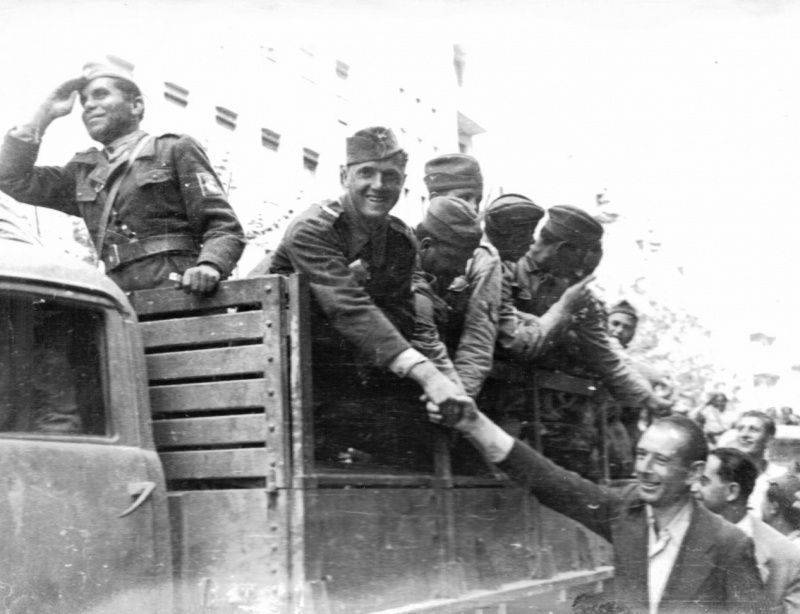
In Romania, parts of the division continued to fight against weapon detachments of the old royal army, who tried to resist the new government. After the Wehrmacht’s retreat, as early as 1944, the leadership of Nazi Germany decided to deploy the partisan movement in Bessarabia, Bukovina and Moldova. First of all, this partisan anti-Soviet movement consisted of loyal fascist ideology officers and soldiers of the royal army, former police and gendarmes, officials of the occupation authorities. Thus, the NKGB of the Ukrainian SSR announces the Romanian Partisans organized by the Romanian and German intelligence in the second half of May 1944, about the bandit squad: “According to the strictly verified data we have, in the Krasno-Putna region the Romanian-German 1 intelligence is organized by a gangster detachment called“ Romanian Partisans ", numbering up to 500 people. In the second half of May, 1944, the German command ordered that the “partisans” operating in the Krasno-Putna region urgently be supplied with the necessary armament and food. Along with this, the Germans gave instructions to develop the movement of "partisans" in the territory of Bukovina, Bessarabia and Moldavia liberated by the Red Army. In order to attract new members to the gang, a leaflet is distributed among the population containing praise of the “struggle of the patriots from Krasno-Putna”. As it is established, the work on the creation of "partisan" detachments is led by Colonel Ionescu, who is the head of the Eastern Front agent department, called "Vultur" 2. People's Commissar of State Security of the Ukrainian SSR Commissioner of State Security of the 3 rank Savchenko "(NKGB SSR COMMUNICATION No. 34050 / 2 IN the NKVD of the Ukrainian SSR ON ROMANIAN PARTISIANS ORGANIZED ROMANIAN NEMOTIC BANDOTRUY) Similar detachments were also formed in Romania after King Mihai moved to the side of the anti-Hitler coalition. It was with them that the Tudor Vladimirescu Volunteer Division was to fight.
Second volunteer
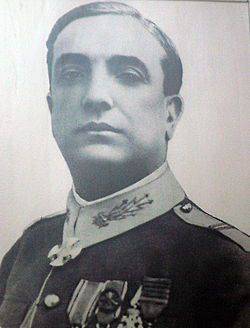 In April 1945, the second volunteer division was formed from among the Romanian prisoners of war in the territory of the Soviet Union. She received the name 2 th Romanian volunteer division "Horia, Cloth shi Krishan." This name was given in honor of three peasants - Horia, Kloshka and Krishana, who stood at the head of an uprising against the power of Austria-Hungary in 1784-1785. The division commander was appointed Major General Mihai Lascar (1889-1959). This general (pictured) was considered one of the best military leaders of the Romanian army in World War II. He began his service as early as the beginning of the twentieth century, graduating from an officer infantry school as a second lieutenant in 1910, and participating in the 2 of the Balkan and World War I, in the 1917 received the major rank, in 1927 he became a lieutenant colonel, and 1934 g. - Colonel. Epaulets of Brigadier General Laskar dressed in 1939. During the war with the Soviet Union, Lascar commanded the 1 th mountain rifle brigade that seized Northern Bukovina, forcing the Dnieper and participated in the seizure of the Crimea.
In April 1945, the second volunteer division was formed from among the Romanian prisoners of war in the territory of the Soviet Union. She received the name 2 th Romanian volunteer division "Horia, Cloth shi Krishan." This name was given in honor of three peasants - Horia, Kloshka and Krishana, who stood at the head of an uprising against the power of Austria-Hungary in 1784-1785. The division commander was appointed Major General Mihai Lascar (1889-1959). This general (pictured) was considered one of the best military leaders of the Romanian army in World War II. He began his service as early as the beginning of the twentieth century, graduating from an officer infantry school as a second lieutenant in 1910, and participating in the 2 of the Balkan and World War I, in the 1917 received the major rank, in 1927 he became a lieutenant colonel, and 1934 g. - Colonel. Epaulets of Brigadier General Laskar dressed in 1939. During the war with the Soviet Union, Lascar commanded the 1 th mountain rifle brigade that seized Northern Bukovina, forcing the Dnieper and participated in the seizure of the Crimea. From 11 in March, 1942 in Lascars commanded the 6 Infantry Division and participated in the attack on Stalingrad. After a total defeat surrendered. By the way, Laskar had serious Romanian and German awards, including the 2-th and 1-grade Iron Cross, Knight's Cross, Oak Branches of the Knight's Cross, Order of Mihai the Brave 2 degrees. After the capture, Laskar was in camps in Suzdal and Ivanovo, then in the camp for senior officers No. 48. 12 April 1945. He accepted the offer to become the commander of the 2 th Romanian volunteer division "Horia, Cloth shi krishan". As in the “Tudor Vladimirescu” division, in the “Horia, Closhka shi Krishan” division it was planned to conduct a long-term political processing of personnel.
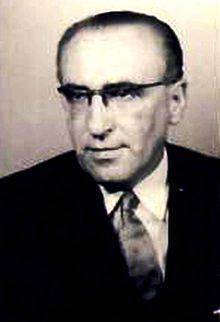 It was supposed that Walter Roman (1913-1983) —the well-known Romanian communist (still in the photo) who had participated in the Spanish Civil War — would become the division's commissar. Like Anna Pauper, Walter Roman was of Jewish origin, but Hungarian, his real name is Ern Н Neulander. However, the division "Horia, Cloth shi Krishan" to take part in the battles and failed. In May, 1945, the Nazi Germany capitulated. Therefore, the division took part in the elimination of the resistance of the pro-fascist armed groups on the territory of Romania itself.
It was supposed that Walter Roman (1913-1983) —the well-known Romanian communist (still in the photo) who had participated in the Spanish Civil War — would become the division's commissar. Like Anna Pauper, Walter Roman was of Jewish origin, but Hungarian, his real name is Ern Н Neulander. However, the division "Horia, Cloth shi Krishan" to take part in the battles and failed. In May, 1945, the Nazi Germany capitulated. Therefore, the division took part in the elimination of the resistance of the pro-fascist armed groups on the territory of Romania itself. Socialist Romania and the fate of volunteers
Some time after the war, the Soviet leadership began organizing the coming to power of the Communist pro-Soviet parties in Eastern Europe. In 1947, the monarchy of King Mihai was overthrown in Romania and a people's republic was established. The key role in ensuring the overthrow of the monarchy and neutralizing the possible resistance of its supporters was played by the 1st and 2nd Romanian divisions - “Tudor Vladimirirescu” and “Choria, Kloshka shi Krishan”, who, after the end of the war, joined the Romanian army, but were under ideological influence the communists. On the eve of the coup, the divisions were motorized and equipped with armored vehicles, turning into the most combat-ready units of the Romanian ground forces. The divisions Tudor Vladimirirescu and Choria, Kloshka shi Krishan became the basis of the ground forces of socialist Romania. The second division was later transformed into tank and consisted of three tank regiments. In 1994, the 6th Army Corps was created on the basis of the second division, and in 2000 a brigade. The fate of the commanders and commissars of the divisions has developed in different ways. The common thing in them is that the communist government of Romania did not trust the old Romanian officers who served under the kings and Marshal Antonescu too much. Nicolae Cambrai in 1945-1947 was the first deputy chief of the General Staff of the Romanian royal army, but after the overthrow of the monarchy, he was demoted and became deputy commander of the 2nd Military District (1947-1948), then - head of the instructor center of the armed forces (1948-1949). The last post of the general was the post of commander of the 3rd military district, and in 1950, Cambrai was fired. Mihai Laskar in 1945-1946 commanded the 4th Romanian army, in 1946-1947. He was the Minister of Defense of Romania, from 1947-1950. - Deputy Minister of Defense of Romania and Inspector General of the Armed Forces. On January 12, 1950, Army General Laskar was fired.
Anna Pauker in 1945-1948 was a member of the Politburo and secretary of the Communist Party of Romania Central Committee, then, after the unification of the Communist Party and the Social Democratic Party - secretary of the Central Committee of the Romanian Workers' Party from February 1948 to May 1952. At the same time she held the post of Minister of Foreign Affairs of Romania in December 1947 - July 1952 yy At the same time, the policy of Anna Pauker displeased the Romanian leadership. She opposed the forced collectivization of Romanian agriculture on the Soviet model, rejected the proposal to build the channel "Danube - Black Sea", put forward by Stalin, then did not support the repression in the Romanian Communist Party, aimed at identifying the alleged supporters of the Yugoslav leader Tito. Stalin was disliked by the nationality of Pauker, who, in the opinion of the leader, could discredit her as the leader of the Romanian workers. Stalin accused Pauker of a right deviation. In February 1953, Mr. Pauker was arrested, but after Stalin’s death, she was released and placed under house arrest. The leadership of the Romanian Workers' Party kept fears about the possible return of Pauker’s strong positions in the party, and therefore kept her under house arrest until her death. Interested in the fate of Pauker Nikita Khrushchev, the party leadership reported that she allegedly adhered to the Stalinist positions and criticized de-Stalinization in the Soviet Union, therefore Khrushchev also did not stand up for Pauker.
In modern Romania, volunteer divisions that were formed in the USSR are called not only the stronghold of the Soviet occupation of Romanian territory. The memory of volunteer soldiers who participated in the fight against fascism in Eastern Europe is completely erased from the memory of young generations of Romanian citizens. Moreover, in the country since the beginning of the 1990's. pro-fascist sentiments are activated, attempts are being made to rehabilitate Marshal Ion Antonescu and the Iron Guard militants.
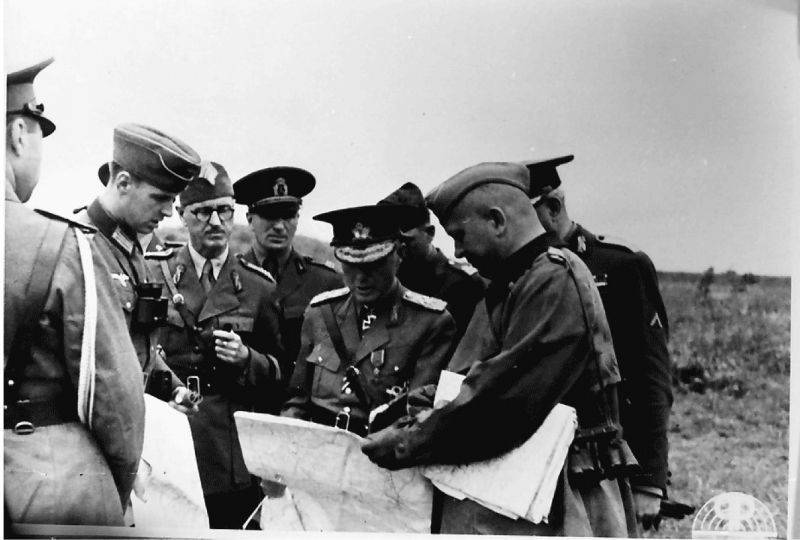
Information